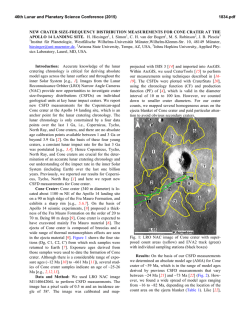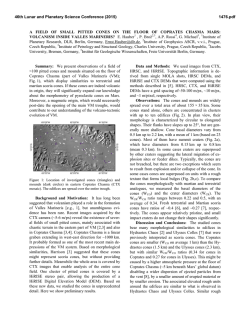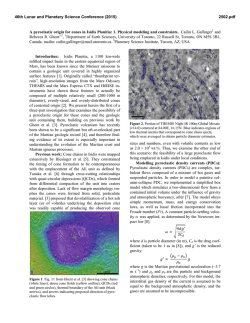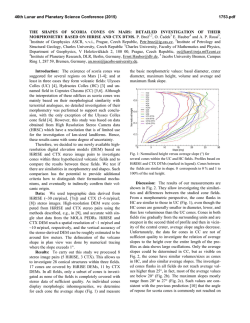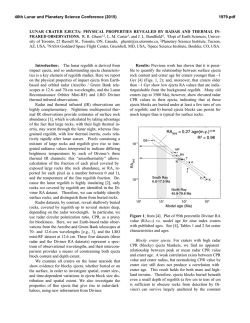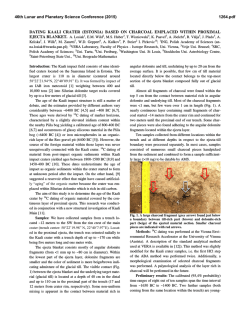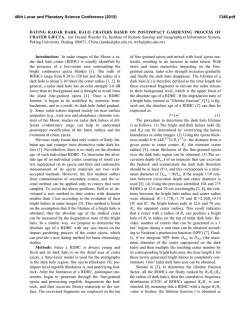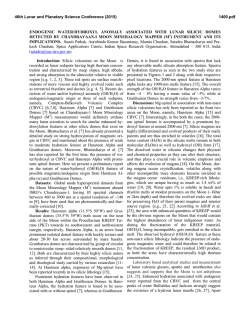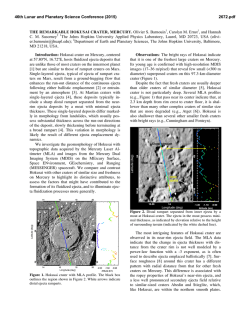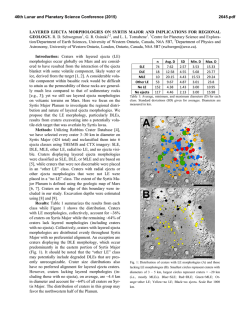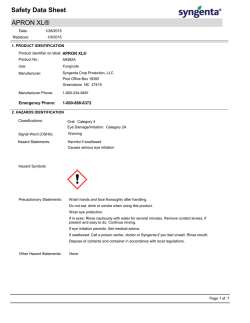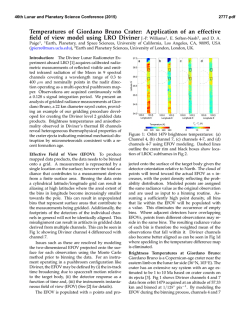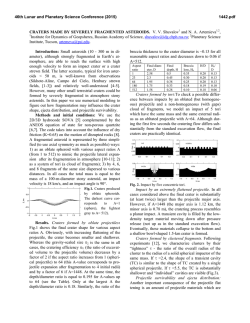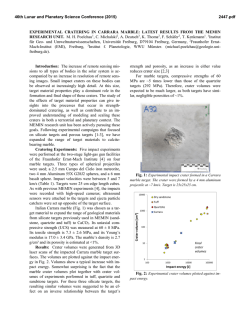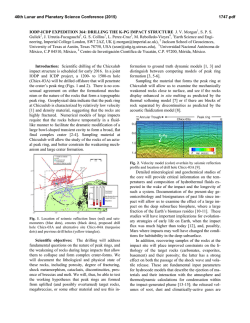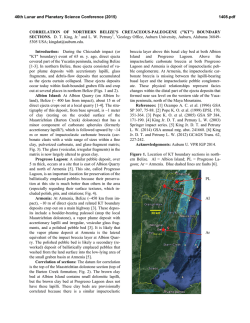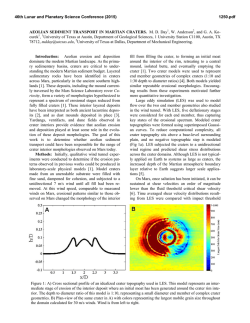
Evidence for Amazonian Highly Viscous Lavas in the Southern
46th Lunar and Planetary Science Conference (2015) 2708.pdf EVIDENCE FOR AMAZONIAN HIGHLY VISCOUS LAVAS IN THE SOUTHERN HIGHLANDS ON MARS. P. Brož1, E. Hauber2, T. Platz3,4 and M. Balme5, 1Institute of Geophysics ASCR, v.v.i., Boční II/1401, 141 31, Prague, Czech Republic, 2Institute of Planetary Research, DLR, Rutherfordstr. 2, 12489, Berlin, Germany, 3 Planetary Science Institute, 1700 E. Fort Lowell, Tucson, AZ 85719, 4Planetary Sciences and Remote Sensing, Freie Universität Berlin, Malteserstr. 74-100, 12249 Berlin, Germany ([email protected]), 5CEPSAR, Open University, Milton Keynes MK7 6AA, United Kingdom. Introduction: Volcanism was globally widespread on Mars in the early history of the planet, but became focused with ongoing evolution on two main volcanic provinces in the Tharsis and Elysium regions [e.g., 14]. Except for the widespread Hesperian ridged plains [5], and some isolated centrers (e.g., Tyrrhenus and Hadriacus Montes [4,6], evidence for post-Noachian (<3.7 Ga) volcanism, and in particular for individual volcanic edifices is rare in the martian highlands. It is generally thought that highland volcanism occurred early in Mars‟ history and stopped not later than ~1 Gyr after planet formation [4,6]. It was long thought that more evolved (i.e., andesitic to rhyolitic) magma compositions are rare on Mars [7-8]. More recently, however, based on orbital spectroscopic observations and rover-based in situ measurements, several studies indicate that evolved magmas may have been generated on Mars [9-12], but there are only few direct observations of kilometerscale edifices that may be composed of evolved magmas [9,13]. In this study [14] we focus on two cones with associated flow apron features, and three domical structures surrounded by flows, which are all located in the southern highlands. They might represent rare evidences of martian equivalents for terrestrial lava domes and coulées caused by highly viscous (i.e., andesitic to rhyolitic) lavas. Location: The study area is located in Terra Sirenum, a highland region which is crossed by approximately E-W-trending Tharsis-radial graben systems and lies within the borders of the proposed former Eridania paleolake ([15]; Fig. 1). At local scale, the area is found within an unnamed depression (centred 41.40°S, 186.80°E) of unknown origin. Several conical and domical landforms (Fig. 2a) are located within an area (~150 km × ~30 km) elongated in E-W direction. A profile across studied cones and domes is provided in Fig. 2b. Methods: For surfaces observations CTX (~6m/px), HiRISE (~0.3m/px), HRSC (10-20m/px), and THEMIS IR day/nighttime data were employed and integrated into a Geographic Information System. Morphometrical analyses were carried out using HRSC-DTMs (50-100m/px), the global MOLADTM (463m/px), and single MOLA PEDR track data. Crater-based model ages were determined using CraterTools [16] and Craterstats [17] and the chronology/production functions of [18-19]. Figure 1: Regional map of part of the southern hemisphere on Mars. Outline of study area (Fig. 2) is shown. Morphology and Age: For clarity only one cone is described in more detail. Cone T1 (41.13°S, 184.85°E) is breached to the south from where a flow apron appears to emanate, partially covering the cone‟s lower flanks (Fig. 3). The cone is about 3 km in diameter and 230 m in height. The flow apron is ~8.5 km wide and spreads as a single, compact unit around the cone, except in the north. The southern edge of the 100-130-m thick flow apron is relatively steep with slopes of approx. 10° and up to 20°. The surface of the flow apron is superposed by two small impact craters (with diameters of ~1.3 km and ~0.8 km) without distinctive fluidized ejecta features. In THEMIS IR nighttime and CTX images a flow-like feature extending south of the flow apron is observed, which partially buries the nearby crater ejecta (Fig. 3). For this flow deposit Cone T1 appears to be the source. The flow apron is too small in areal extend to determine a crater-based model age. Therefore, the impact crater populations on the nearby crater ejecta and Flow 1 are mapped (Fig. 3). Both units were emplaced over a short internal at about 660±110 Ma (Flow 1) and 700±140 Ma (ejecta). Discussion: The domes and cones in the study area stand several hundred meters above the surrounding plains and are partially superposed on wrinkle ridges. They exhibit well-preserved shapes and neither the cones nor the domes show much evidence for signifi- 46th Lunar and Planetary Science Conference (2015) cant erosion (except a few small gullies), yet the morphological interpretation is not straightforward and depends upon the regional context. The study area is located in the southern mid-latitudes, where glacial and/or periglacial activity has produced a range of icerelated landforms [e.g., 20]. For example, [20] suggest that the martian regolith is deformed by quasi-viscous flow due to creep deformation of ice, a process known as „terrain softening‟ [21]. A characteristic class of landforms related to this process are lobate debris aprons [22], which in some ways have similar morphologies to the flow aprons around cones T1 and T2. However, several aspects (e.g., flow lineations, “brain terrain”, ring-mold craters; [23-24] make it unlikely that cones T1 and T2 are surrounded by lobate debris aprons. In addition, impact crater formation on an icerich target material would have formed single or multilayered, lobate rampart ejecta. This is not observed (cf. western crater ejecta on Cone T1 flow apron; Fig. 3a). 2708.pdf an origin related to volcanism rather than to water and/or water ice. The morphological similarities to terrestrial lava domes, coulées, and obsidian flows raise the possibility that the studied features represent a suite of volcanic landforms associated with evolved magmas. Figure 3: Portrait of horseshoe-shaped cone T1 (arrow) and associated flow apron including adjacent impact crater (younger) and flow deposit (flow 1; older). Blue and green outlines and red circles mark counting areas and impact craters, respectively. Figure 2: (a) Cones and domes as observed in the study area (THEMIS IR daytime). (b) Cross-sectional profile from west to east (left-right) across all marked landforms. Cones T1 and T2 are breached and flow aprons seem to originate from the centrers of craters on the top of the cones. This suggests that material likely extruded from the subsurface through the craters to the surface, rather than originated at alcoves on the flanks of the cones, as it is typical for flowing ice-rich material [25]. A simple comparison between observations and expected characteristics of lobate debris aprons illustrates that an origin of the aprons by the flow of ice-rich material is highly unlikely. Because glacial/peri-glacial formational processes can be ruled out to have formed these conical and domical landforms, we conclude that only volcanism is the most probable explanation for the formation of the edifices and associated flows. This conclusion is supported by the inspection of OMEGA-based global maps [26], which suggest that exposed rocks atop Domes B and C and Flow 3 have low abundances of olivine and moderate amounts of pyroxene, favouring References: [1] Werner S. C. (2009) Icarus, 201, 44-68. [2] Robbins S. J. (2011) Icarus, 211, 1179-1203. [3] Platz T. & Michael G. G. (2011) EPSL, 312, 140-151. [4] Xiao L. et al. (2012) EPSL, 323-324, 9-18. [5] Greeley R. & Spudis P. D. (1981) Rev. Geophys., 19, 13-41. [6] Williams D. A. et al. (2009) Planet. Space Sci., 57, 895-916. [7] Bandfield J. L. et al. (2004) JGR, 109, E10009. [8] Christensen P. R. et al. (2005) Nature, 436, 504-509. [9] Skok J. R. et al. (2010) Nat. Geosci., 3, 838841. [10] Wray J. J. et al. (2013) Nat. Geosci., 6, 10131017. [11] Stolper E. M. et al. (2013) Science, 341, 1239463. [12] Sautter V. et al. (2014) JGR, 119, 30-46. [13] Rampey M. L. et al. (2007) JGR, 112, E06011. [14] Brož P. et al. EPSL, in revision. [15] Irwin R. P. et al. (2004) JGR, 109, E12009. [16] Kneissl T. et al. (2011) Planet. Space Sci., 59, 1243-1254. [17] Michael G. G. & Neukum G. (2010) EPSL, 294, 223-229. [18] Hartmann W. K. & Neukum G. (2001) Space Sci. Rev., 96, 165-194. [19] Ivanov B. (2001) Space Sci. Rev., 96, 87-104. [20] Squyres S. W. & Carr M. H. (1986) Science, 231, 249252. [21] Jankowski D. G. & Squyres S. W. (1992) Icarus, 100, 26-39. [22] Squyres S. W. (1978) Icarus, 34, 600-613. [23] Kress A. M. et al. (2008) GRL, 35, L23206. [24] Levy J. et al. (2010) Icarus, 209, 390-404. [25] Head J. W. et al. (2010) EPSL, 294, 306-320. [26] Ody A. et al. (2012) JGR, 117, E00J14.
© Copyright 2025
